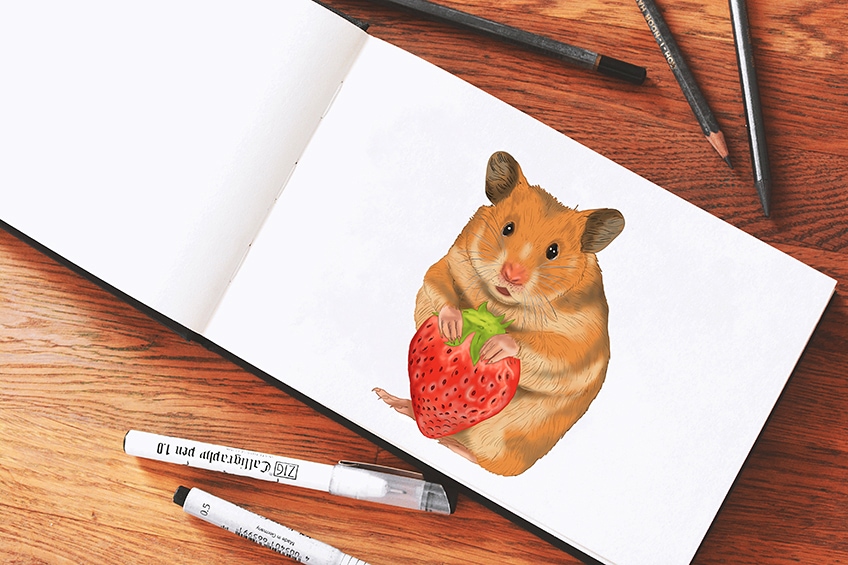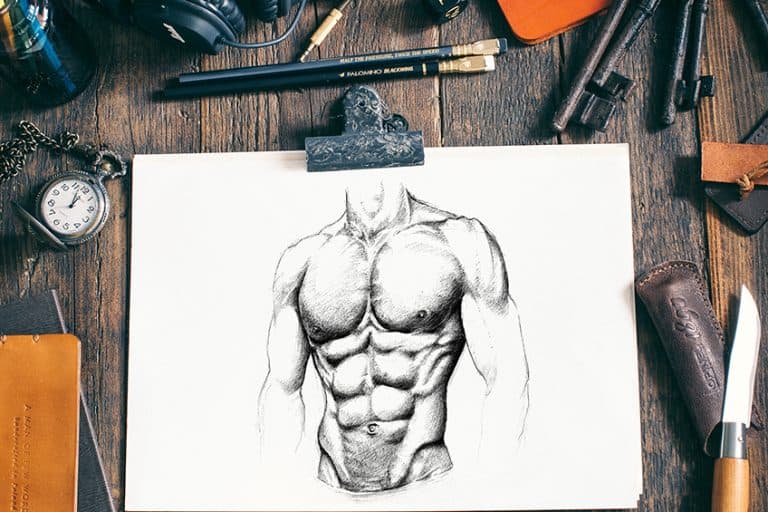How to Draw a Hamster – An Adorable Hamster Drawing Tutorial
Of all the little fluffy friends we love, hamsters are up there contending for the title of cutest. With their tiny delicate feet, bright eyes, twitching noses, and big ears, hamsters can be quite tricky to draw. Luckily, if you want to create a realistic hamster sketch, you have come to the right place. With our easy-to-follow hamster drawing tutorial, you can master the basics and create a very cute, realistic hamster sketch.
A Step-by-Step Hamster Drawing Tutorial
We have put together this very easy-to-follow tutorial to help you create a cute hamster sketch in no time. The great thing about this tutorial is that you can follow it using a range of mediums. If you are a watercolor artist or colored pencil artist, you can quickly and effortlessly adapt the instructions. We’ve used a graphic tablet to create this tutorial, so you can see that adaptation is the name of the game. Learning how to draw a hamster is a fantastic way to practice creating small and intricate details, like the nose, paws, and eyes. You will also learn more about drawing realistic fur and the basics of construction lines and dimensions.
Step 1: Constructing the Body of Your Hamster Sketch
For many beginner artists, knowing where to start tackling a complicated subject like a hamster is the most difficult part of the drawing stage. If you were to start by drawing the head and facial features, and then discover that you have not left enough space for the rest of the body, you are likely to feel a little disheartened.
It is to avoid these problems that we like to begin every animal drawing with construction shapes and lines. Using basic shapes and lines to plan out the fundamental shape of our animal before we add any details, helps us make sure we have the right proportions and that we can fit our whole drawing on the canvas.
When it comes to drawing animals, the most common shape we use as the foundation for the body as a whole is an oval. You can probably see it coming, but we are going to begin constructing our hamster sketch with an egg-shaped oval. You want the top of your oval to lean slightly to the left, as you can see in our example below. The most important thing to remember in this first step is to make sure that there is plenty of space all around your oval, leaving room for other construction lines.

Step 2: Constructing the Head
Because we are drawing the hamster sitting on its back legs, the head overlaps quite significantly with the body. You can imagine that the hamster’s shoulders are behind its head, as it is sitting slightly hunched over. As a result of this perspective, you need to make sure that the oval you use for your head overlaps with the top of the main body oval quite a lot.
The oval you use to represent the head should not be as long as the one you drew for the main body. In fact, the head should be more of an uneven circle than an oval.

Step 3: Constructing the Face
As a result of the position that we are choosing to draw the hamster in, we are drawing its entire face. The most important part of drawing any face, be it human or animal, is to get the dimensions and placement of all the features spot on. If the eyes are slightly too far apart, or the nose is too high, you can very quickly create a strange-looking creature! To avoid any of these mistakes, we are going to draw some construction lines in the head to help us plan out the facial features correctly. Just above the central point of the head circle, draw a line that crosses the head oval horizontally, and then a vertical line that bisects with this line in the center.
If you look at our example below, you will see that the facial construction lines are not horizontal and vertical in the traditional sense, but relative to the angle of the head circle.

Step 4: Constructing the Strawberry
You will be able to see in the main image for this tutorial that the hamster drawing features a large juicy strawberry. The addition of the strawberry is a stylistic choice, making it easier for us to draw the hamster’s hands. If you do not fancy including the strawberry, you are welcome to leave it out, but if you want to follow along with us, we are going to use a slightly oval shape to construct the strawberry.
While the other two oval shapes that we have used so far have been angled slightly to the left, the strawberry construction circle can be directly upright. You want the strawberry oval to overlap quite significantly with the body of the hamster, and sit just to the left of the bottom point in the main body oval.

Step 5: Constructing the Arms and Paws
It may be tempting at this stage of the hamster drawing tutorial to disregard the construction lines and just start drawing the arms fully, but when it comes to the step where we draw the full outline, you will be grateful to have stuck with the process!
For the arms of the hamster, you are going to use two inverted lines that curve down and into the center of the main body oval. You want the ends of these arm lines to meet the outline of the strawberry construction circle. At the end of these arm construction lines, draw two slightly uneven oval shapes that overlap the strawberry shape significantly.
In the next few steps, we are going to use these uneven ovals to help us draw the fingers on the hamster’s paws.
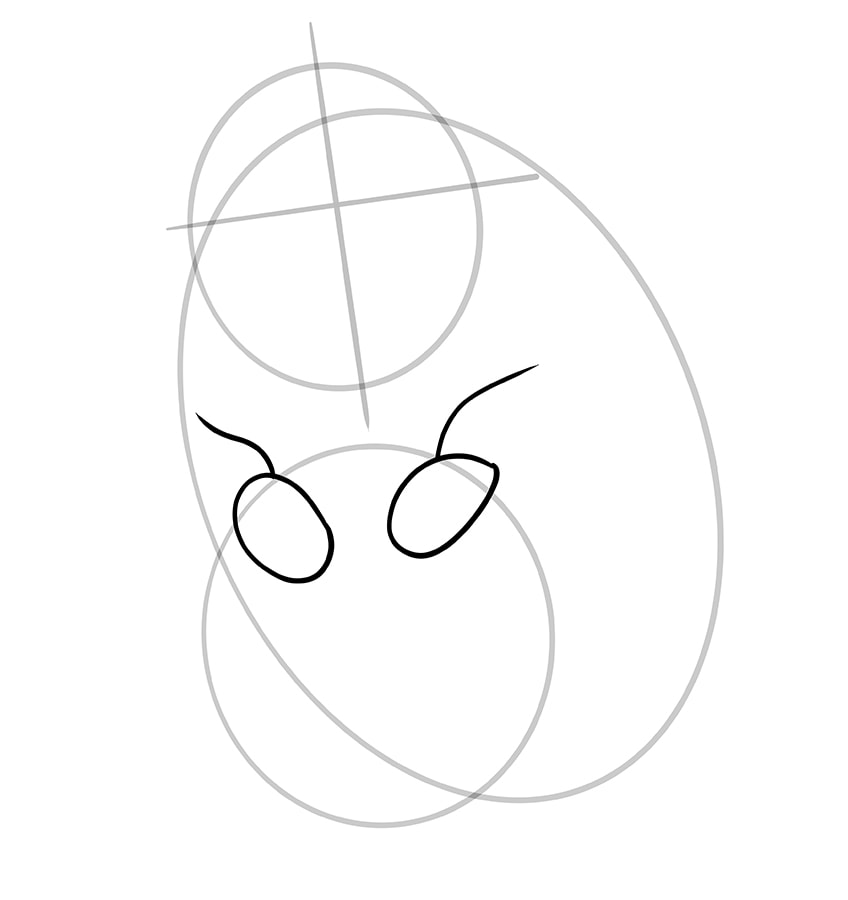
Step 6: Constructing the Feet
This step is relatively straightforward, as you are simply laying down the foundational shape of the two bottom feet sticking out from under the hamster’s body. The feet, which are facing outwards like a ballet dancer, can be represented by two narrow and uneven ovals. Both ovals should start on the strawberry construction oval.
The foot that is on your right side, can overlap slightly with the main body oval, while the second should only be partially visible, as the strawberry will be blocking our view of it.

Step 7: Constructing the Ears
This seventh step is another very simple step, and it is the last construction step before we begin to fine line the final shape of the hamster. For the hamster’s ears, you are going to use two elongated and almost square ovals. For the right ear, you want to have the bottom of this oval overlap with the point of overlap between the head and body construction shapes. For the left ear, simply find the equivalent spot on the left side of the head.
The hamster’s ears face outwards slightly, so you want to make sure that both of your ear construction shapes slant slightly away from the facial center line.

Step 8: Outlining the Head of Your Hamster Drawing
It is finally time to start putting our construction lines to use to create the final outline of the hamster’s body. We have split the outlining process into several stages because the hamster is quite intricate and we want to make sure each step is as clear and easy-to-follow as possible.
Using the general shape of the construction line to help you, begin by using short strokes of your pen to draw the very top part of the hamster’s head. You want to give the impression of fur with these short strokes. When you have completed this top part, take a smooth line onto each of the ear construction lines. You can outline the ears with smooth lines, but when it comes to the bottom of the ear ovals, create lines using short strokes that cut across the bottom of the oval. You can then continue to use these short strokes to outline the rest of the face.
You can see from our example that you should not follow the shape of the construction oval exactly. Around the cheeks, you can take the line out significantly further than the construction line to create the chubby cheeks of your hamster.
When you get to the bottom of the hamster’s face, you can bring the outline up slightly to meet on the central face construction line. Finally, draw two oval lines below this point to represent the mouth and lower lip. Both of these lines can be slightly furry.
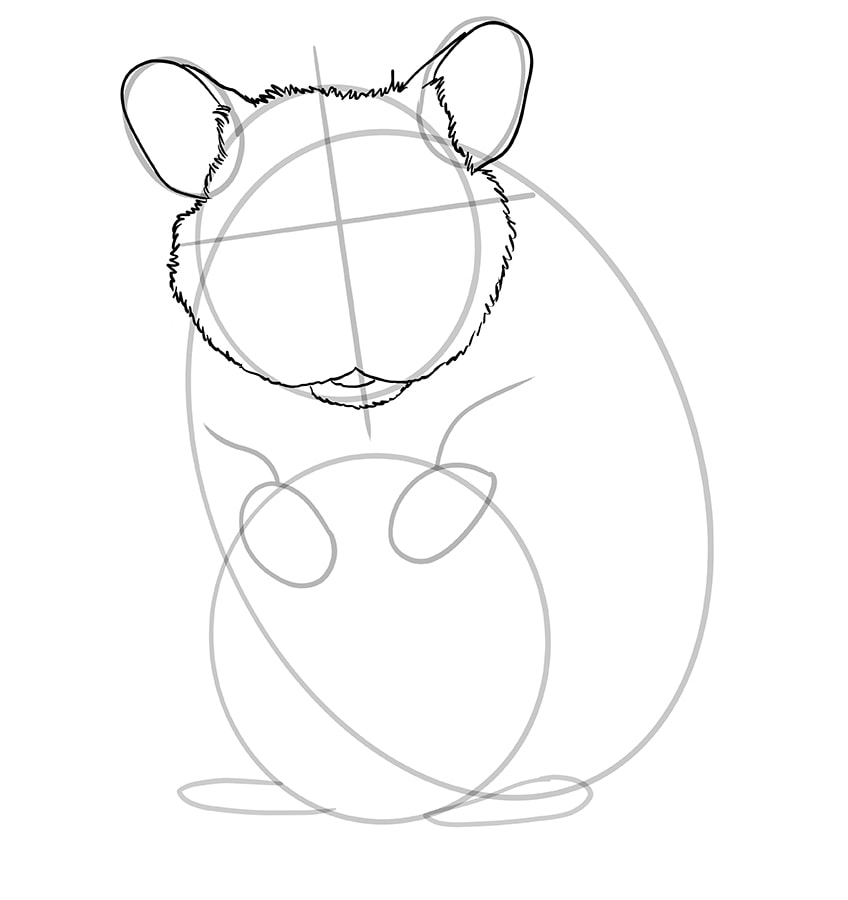
Step 9: Outlining the Rest of the Body
In this step, you are going to use all the other construction lines to outline the shape of your hamster’s entire body. To create the realistic impression of fur, you need to use the same short strokes to complete the whole outline, excluding the hands and feet.
As with all drawing tutorials using construction lines, the trick is not to follow them too closely. For the outline of the main body, for example, you can add a few lumps and bumps to make the outline more realistic.
For the hands and feet, use the construction shapes to help you shape the features. Draw four fairly chunky little fingers on each of the hands, and three on each foot. Make sure that you draw the right foot with the toes facing the left! Finally, add some sharp little nails to each finger and toe.
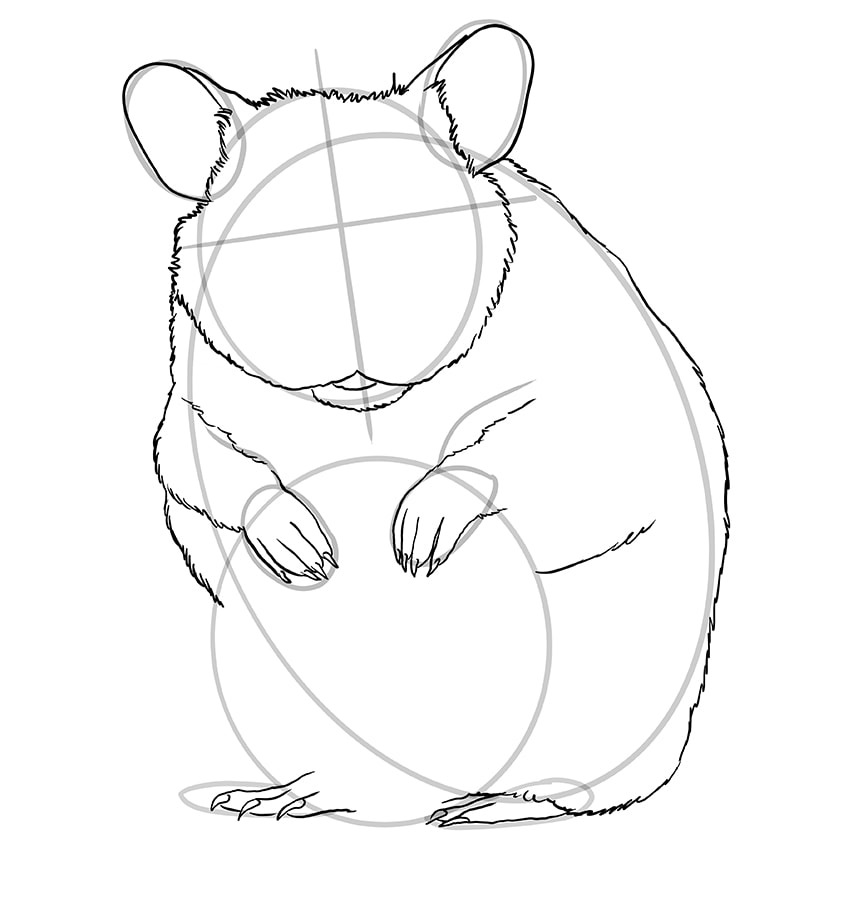
Step 10: Outlining the Strawberry
Because we have the construction line, outlining the strawberry is very easy. You can also use the position of your hamster’s hands to help you draw the strawberry, making it look like the hamster is holding onto the sweet juicy fruit. You can also use the feet to help you shape the bottom of the strawberry.
To add the final touches of realism to the shape of your strawberry, add some leaves and even a small stem to the top.

Step 11: Drawing the Facial Details
In this step, we are going to use the construction lines in the face to draw the hamster’s eyes, nose, and whiskers. Begin by drawing two eyes on the horizontal construction line. You want these eyes to be slightly almond-shaped, with a wider base and a more pointy top. Leave one or two blank dots inside the eye, to represent the reflection of light in the iris.
Further down the vertical construction line, just above the mouth, draw two curved lines that look a little like a “3” lying on its back. These curved shapes represent the nostrils of the hamster. Around this nostril, add some dotted details, and finish the face by adding quite a few whiskers on either side of the nose.
When you are happy with your hamster’s face, you can erase all the construction lines that are still visible.
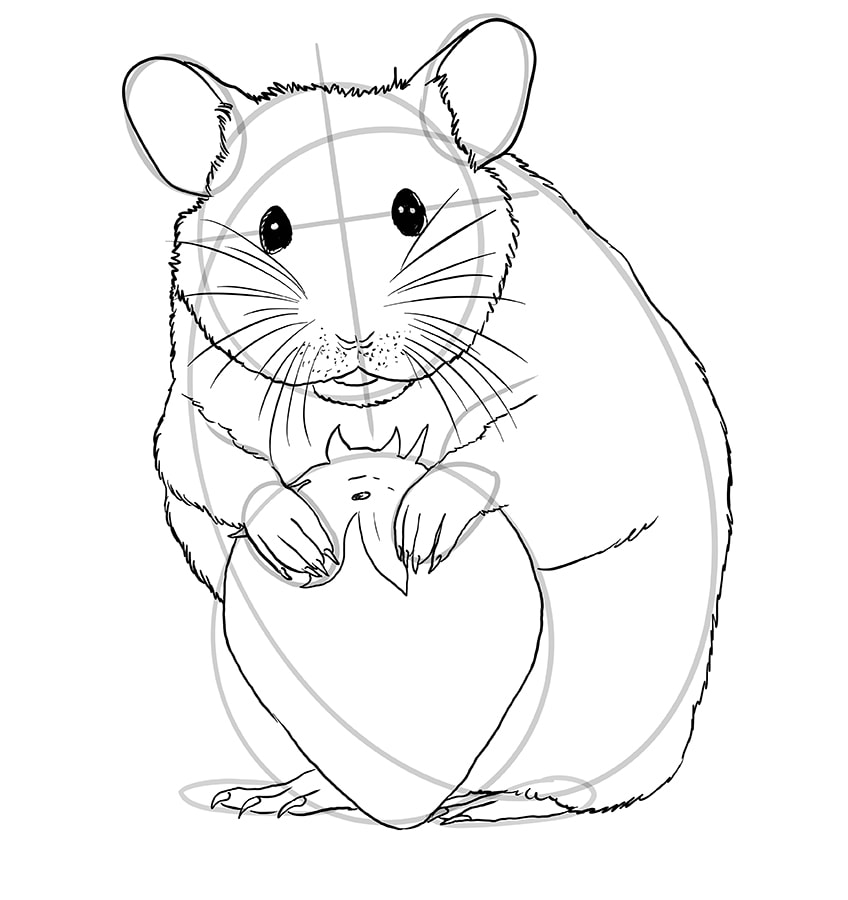
Step 12: Adding Fur and Fine Details
In this step, we are going to add a fur texture to the whole body of the hamster and add the pip details on the strawberry. For the strawberry, draw some slightly uneven oval shapes throughout the body of the strawberry.
Begin adding fur to the head, with a few gentle hairlines flowing out and up from the center of the face. You want to make sure that the fur flows equally in all directions around the facial features. You can also add some fine streaks of hair inside the hamster’s ears. Continue to add fur throughout the rest of the hamster’s body, but do not add fur to the hands or feet.
To make your hamster look as realistic as possible, you should follow the curves of the body with the hairlines. You can also use a range of longer and shorter lines to create natural variety.
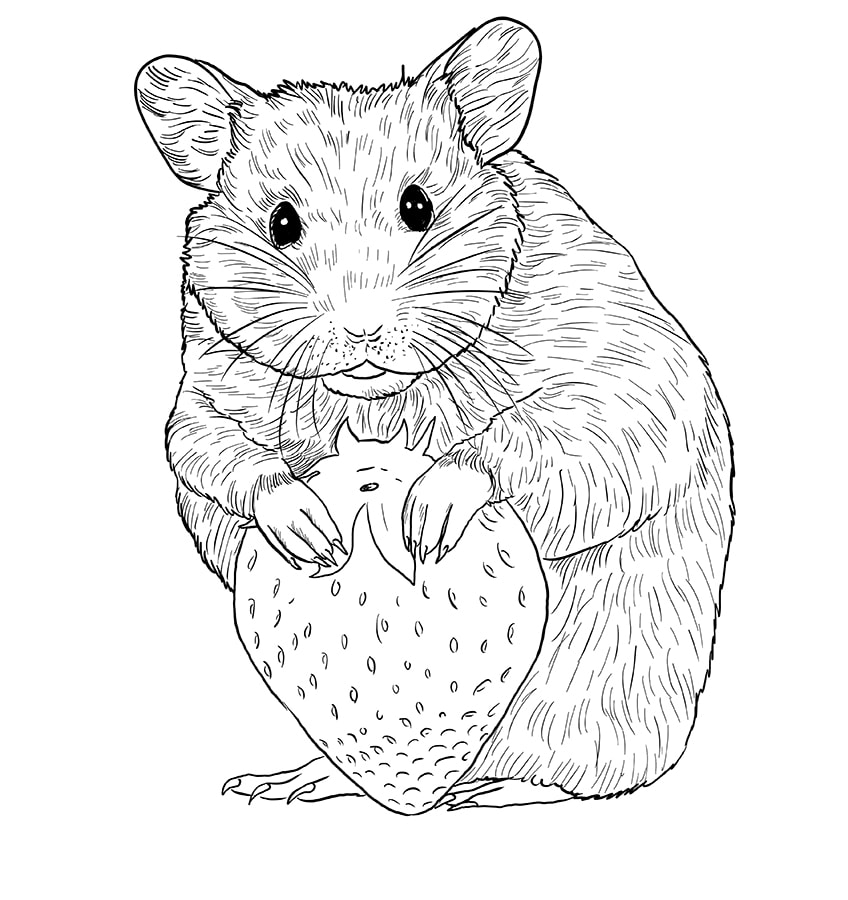
Step 13: Adding the First Coat of Color
When it comes to achieving a natural look with the color of your hamster drawing, we need to work in several layers. We begin with a base coat, and then we will add highlights and shadows for depth and realism. For the base coat, you should choose quite a light brown shade of paint or pencil. You can use this color to color the entire body of the hamster, including the hands and feet.
Rmemeber not to color the strawberry in!
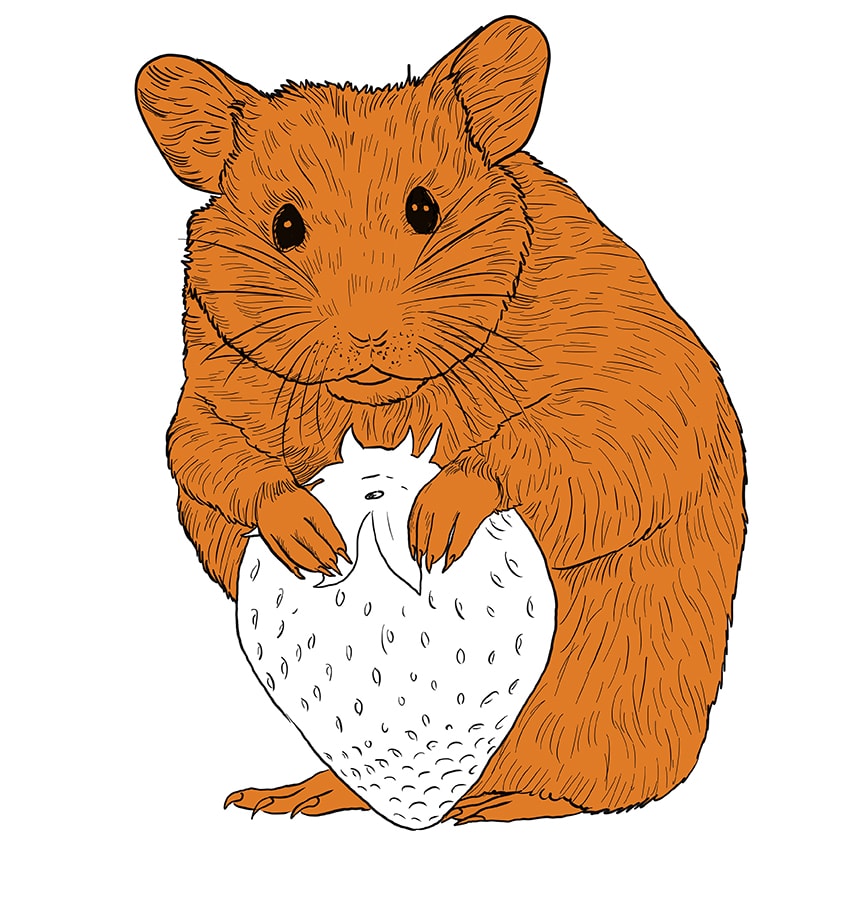
Step 14: Adding the First Coat of Color to the Strawberry
We are also coloring the strawberry in two stages. In this first strawberry coloring step, you can use light green for the leafy top and a nice bright red shade for the body of the juicy strawberry.

Step 15: Adding Shading to Your Hamster Sketch
Shading is an essential feature of any realistic drawing. To add shading to your hamster drawing, find a light black or dark brown shade. Using a very light touch, add a little shading to the inside of the hamster’s ears, under the hamster’s chin, under the arms, on the top of the head, around the nose, and around the hamster’s back. You can also add a touch of shading around the base of the hamster’s hands, and in between the fingers.
The trick with shading is to make sure that it is very light. Because you are adding a dark color, it is easy to over do it quickly. It is always best to start as lightly as possible, because you can always add more.

Step 16: Adding the Secondary Coat of Color
For the second coat of color, you should use a light beige or white shade. You want to focus this lighter color on the front of the hamster’s body. On the face, add the light color around the hamster’s mouth, around the nose, and on the bridge of the nose. You can then add the light color to the front of the hamster’s chest, on the bottom of the arms, and on the bottom of the hamster’s belly.

Step 17: Adding Highlights and Contours
For a little more shading, use a light grey shade and gently contour the inner ears and the face. Begin with a soft brush using grey paint to add gentle contouring to the inner ears and lightly around the face. Next, choose a light pinkish or peach shade to color the nose, and then use the grey again to contour the nostril holes. You can use this same shade of pink to color in the hamster’s mouth.
For the hands and feet, apply a patchy coat of white paint followed by a coat of light pink shade. You can finish this step by using a dark black color to darken the eyes and adding a touch of white to the reflection spots.

Step 18: Adding Highlights to the Strawberry
To make the strawberry look a little more realistic, we are going to add shadows and highlights. Using a very small brush and a dark shade of red, color in the very center of each pip. Once you have each of your dark pips in place, use a white shade to lightly create curved frames around each pip. The top of the strawberry should have the lightest highlights, and you can use fewer highlights towards the bottom.
To add realism to the strawberry leaf, add a little yellow highlight.
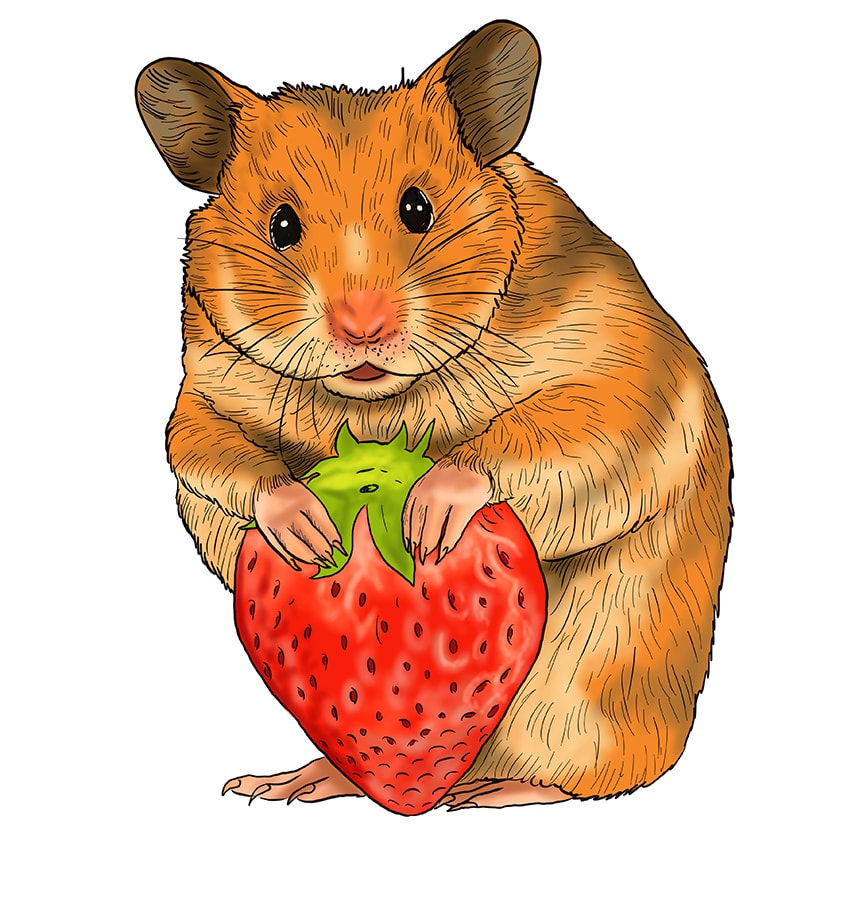
Step 19: Completing Your Hamster Drawing
If you are happy with your drawing, you can leave it at that. For a more realistic finishing touch, however, you can remove the outline. You can either erase the outline or trace over it with the color of the area that it crosses. For the final touch, trace all the fur with a sharp fine brush using brown paint.
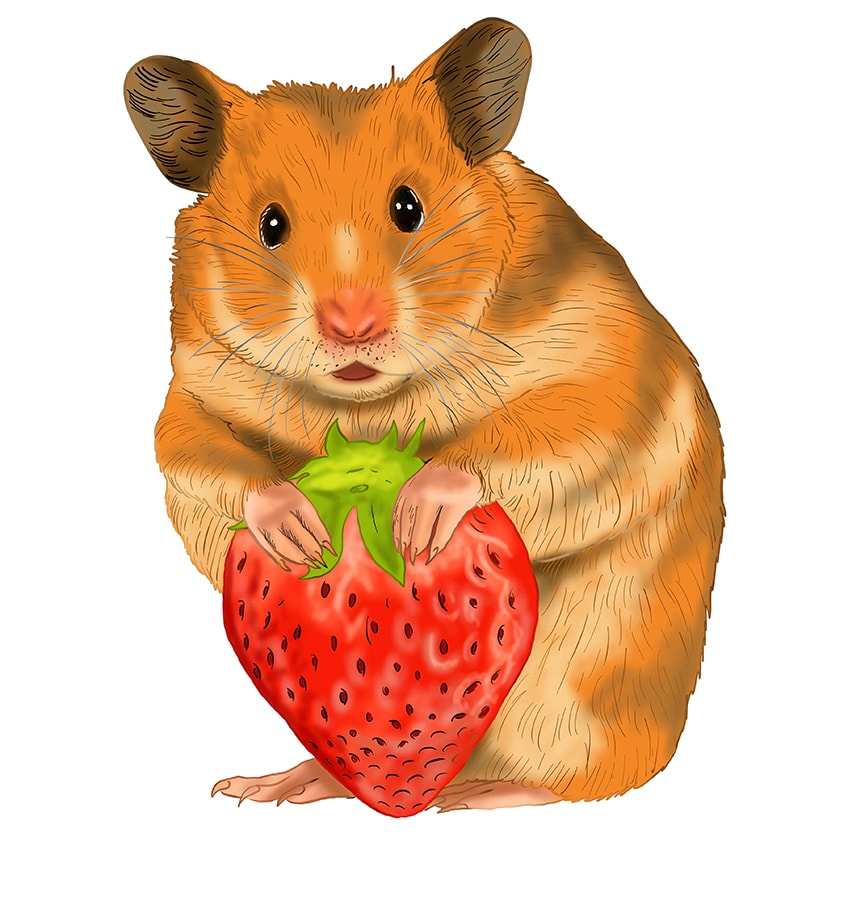
Congratulations for coming to the end of our hamster drawing tutorial! We really hope that you have enjoyed the tutorial and that you are happy with your final drawing.
Frequently Asked Questions
Can a Beginner Follow This Tutorial?
Absolutely, this tutorial is designed for use by any artist who wants to know how to draw a hamster. Whether you are a beginner or an advanced animal drawing artist, you can easily complete every stage of this easy-to-follow tutorial.
Why do You Use Construction Lines?
Construction lines are the best method for animal drawing because they help you nail the proportions and shape of your animal before you begin to add intricate details.
Matthew Matthysen is an educated multidisciplinary artist and illustrator. He successfully completed his art degree at the University of Witwatersrand in South Africa, majoring in art history and contemporary drawing. The focus of his thesis was to explore the philosophical implications of the macro and micro-universe on the human experience. Matthew uses diverse media, such as written and hands-on components, to explore various approaches that are on the border between philosophy and science.
Matthew organized various exhibitions before and during his years as a student and is still passionate about doing so today. He currently works as a freelance artist and writer in various fields. He also has a permanent position at a renowned online gallery (ArtGazette) where he produces various works on commission. As a freelance artist, he creates several series and successfully sells them to galleries and collectors. He loves to use his work and skills in various fields of interest.
Matthew has been creating drawing and painting tutorials since the relaunch in 2020. Through his involvement with artincontext.org, he has been able to deepen his knowledge of various painting mediums. For example, watercolor techniques, calligraphy and lately digital drawing, which is becoming more and more popular.
Learn more about Matthew Matthysen and the Art in Context Team.


